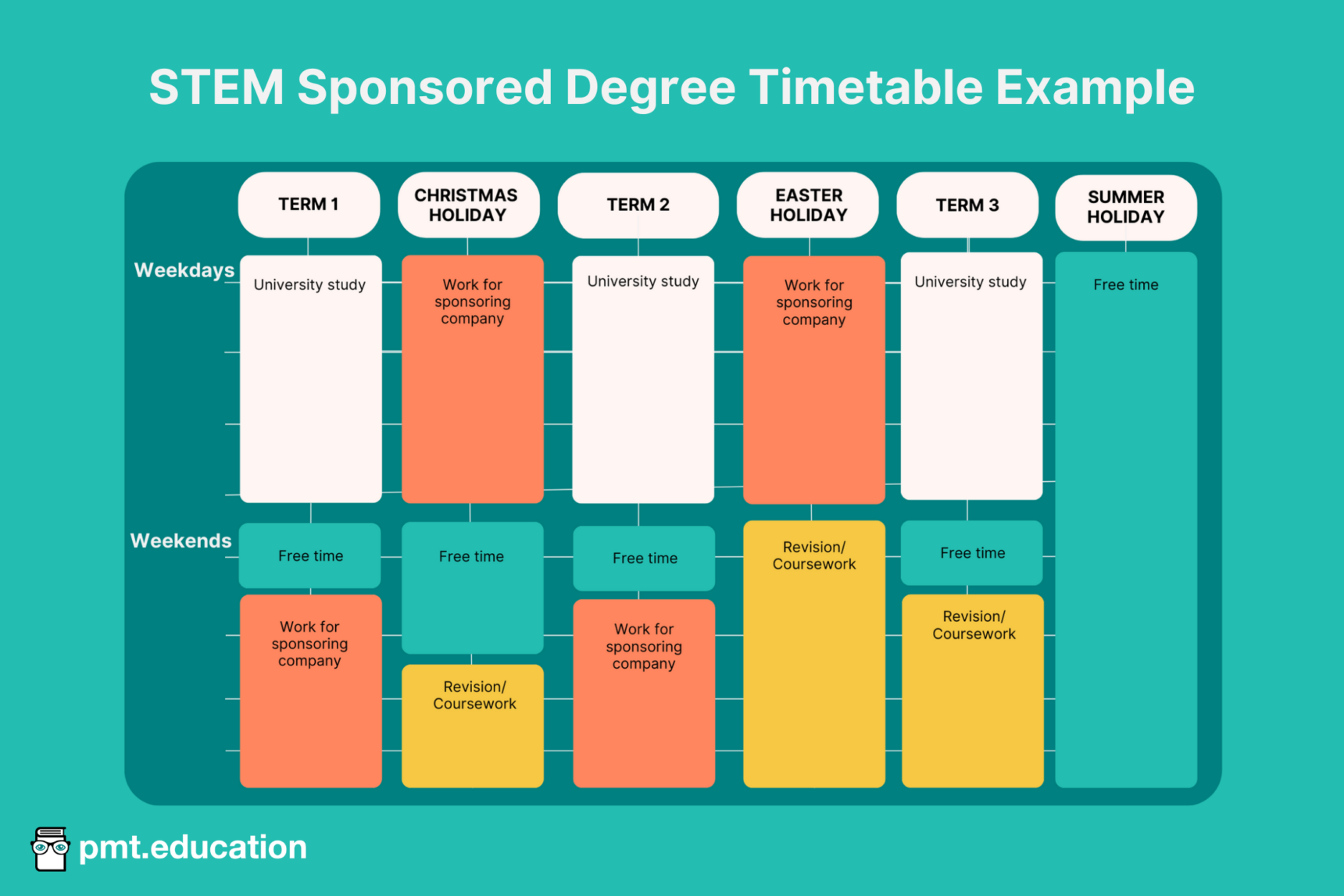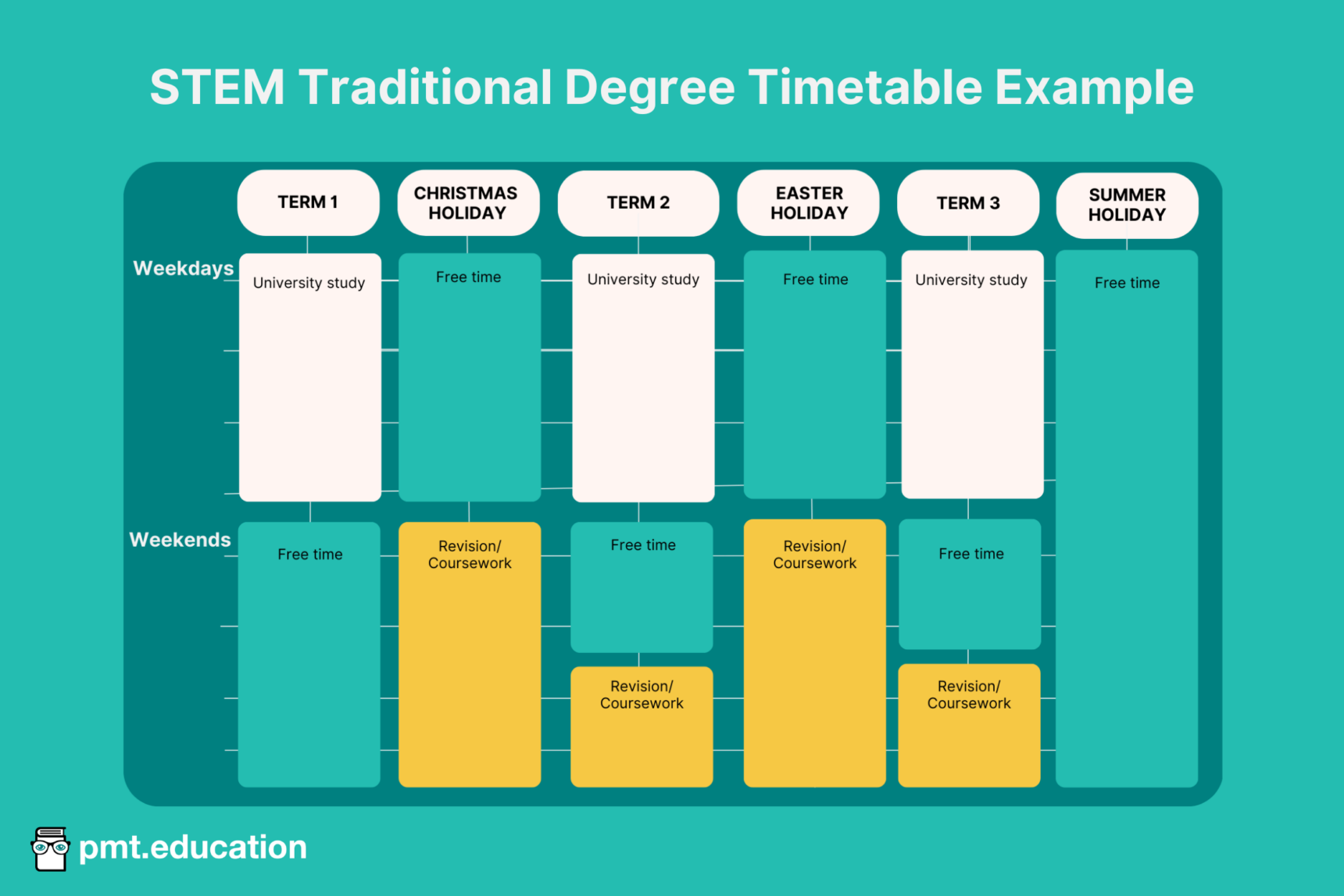Contents:
Concerned about the financial burden that comes with university? A sponsored degree might be the answer!
A sponsored degree offers you the unique opportunity to pay less for a full-time university degree through support from a company in your STEM field of interest. Companies offer degree sponsorship in return for your participation in work experience and, often, your agreement to work for them when you qualify.
This guide will help you understand how sponsored degrees work, the benefits they offer, and how to secure one. It will also explain the key differences between sponsored degrees and degree apprenticeships, helping you choose the best path for your STEM career aspirations.
What sponsored degrees are there in STEM?
Sponsored degrees are particularly well-suited to STEM fields, as their blend of education and practical work develops essential transferable skills for STEM careers. Many companies offer sponsorship for STEM degrees because they recognise the value of employees who not only have strong university-level knowledge but are familiar with the company’s operations, thanks to their practical experience.
Unlike traditional university degrees, sponsored degree options are often limited to courses and universities that companies choose to support. Most companies only sponsor specific degrees that align with their workforce needs, while a few may offer sponsorship for a wider range of degrees.
Here, you can explore examples of sponsored degrees available across each STEM discipline. To search for all your options, follow our advice on how to find a STEM degree.
- Science: Sponsored nursing associate course, available at Buckinghamshire New University, University of East London or The Open University
- Engineering: Royal Airforce sponsored degree in engineering, for those who plan to join the RAF as an Engineer or Cyberspace Officer
- Mathematics: PWC’s accounting degree sponsorship, available at the University of Newcastle, Manchester, Nottingham, Reading, and Queen Mary University of London
Sponsorship opportunities are available across multiple STEM fields, and the level of degree a company will sponsor can range from bachelor’s to master’s degrees.

What is a sponsored master’s degree?
A sponsored master’s degree in the UK is a popular option because, unlike a bachelor’s degree, government funding often falls short of covering the full cost of a master’s degree, and maintenance loans are unavailable. Therefore, many students turn to sponsored degrees as a way to pursue a postgraduate education.
Beyond advancing your education, sponsored master’s degrees allow you to establish strong connections within your chosen STEM industry, creating a smoother transition into the workplace upon graduation.
How do STEM sponsored degrees work?
There are two main components to a sponsored degree: employment and education. However, there are many pathways into STEM that combine practical skills with academic learning, so what sets a sponsored degree apart?
Unlike other pathways, sponsored degrees place a heavier emphasis on academics, allowing you to study full-time like any other other student. A STEM-sponsored degree is one of the few options offering a full-time university degree with interspersed work placements at the sponsoring company. Your employment fits around your studies, often taking place during holidays or time off. For example, PWCs accounting sponsored degree sets aside a few terms for work and training, whilst the RAF requires summer work.
Sponsored degree stages
From application to completion, sponsored degrees tend to conform to the following steps:
- A selection of sponsored degree options are identified
- Applications are sent to the corresponding university courses
- The student is accepted onto a course
- Applications are sent for sponsorship (which can be done before course acceptance)
- The student is accepted into a sponsored degree
- An agreement is signed by the sponsoring company and the student
- The sponsoring company provides financial support to the student in different ways, depending on their specific agreement
- The student attends university and works for the company during time off
- Upon graduation, the student is usually required to work for the company for a specified time period
A typical year of a STEM sponsored degree student
Sponsored degree students often have busy schedules, as they must balance both university studies and work placements. During term time, these students are expected to attend classes and focus on their studies full-time like other students. However, during holidays or designated placement periods, they work for their sponsoring company, applying what they’ve learnt in a real-world context.
The image below shows a typical year for a STEM sponsored degree student, compared with the timetable for a non-sponsored, traditional university student:
How much do sponsored degrees pay?
The financial support provided by a sponsoring company can vary based on the company and the field of study. This support may include coverage of university fees, bursaries, or scholarships.
Bursaries are monetary payments which do not need to be repaid and are usually awarded to all students enrolled in a sponsorship programme.
Scholarships are competitive and are awarded to students who meet particular criteria. They usually provide a higher level of support compared to bursaries.
While there are scholarships and bursaries for non-sponsored degrees, those associated with sponsored degrees are generally more substantial due to the work commitment involved.
How are bursaries and scholarships paid?
When a scholarship or bursary is provided, students are paid directly to their personal account at the time specified in their agreement (e.g. at the start of their degree).
University fee cover involves sponsors paying either the full, or partial cost of tuition. Occasionally, additional support with maintenance fees is included.
How is university fee cover paid?
When covering university tuition, the university sends an invoice to the sponsor, who then pays the university directly.
Some companies offer a combination of compensation options. For example, the Royal Air Force provides a £5000 bursary per academic year, covers tuition fees up to £9250, and offers up to £1500 for 30 days of training.
How to get a sponsored degree
How to find a STEM sponsored degree
There are two main methods for finding a sponsored degree:
- Applying to advertised opportunities: Some companies advertise their ability to sponsor degrees on their websites or comparison sites. These opportunities often involve pre-established sponsorship contracts for specific degrees at particular universities, with set entry requirements and work agreements.
- Reaching out to companies speculatively: This proactive method involves directly contacting companies that you believe may offer you sponsorship for the university course you are interested in. Often, companies will sponsor their current employees who express an interest in furthering their education, as it benefits them to have staff with more advanced training.
In practice, most sponsored degree opportunities are discovered through speculative enquiries. Few STEM sponsored degrees are advertised, and many of those that tend to be degree apprenticeship programmes that are incorrectly labelled as ‘sponsored degrees’.
To find advertised STEM-sponsored degree opportunities, start with your school’s career services, which often maintain a list of companies offering sponsored degrees. Additionally, explore online platforms such as the Sponsored Degree and Scholarship Hub, which specialise in advertising these opportunities.

How to make a speculative enquiry
To increase your chances of a positive response when making speculative enquiries about sponsored degrees, follow these best practices:
- Contact the right people: Demonstrate your understanding of the company’s structure by contacting the appropriate departments, such as the hiring team, HR, or talent acquisition. These are typically the teams responsible for handling sponsorship requests.
- Use the right means of contact: Email is usually the most effective method for communicating your request, as it allows you to share all the information needed for your enquiry in a clear and traceable way. You could also attend careers fairs and networking events, or use platforms such as LinkedIn, to meet employers organically and discuss the possibility of sponsorship.
When reaching out to companies directly, there is no guarantee of their interest as there is with an advertised opportunity. Therefore, it is important to first explain your sponsorship proposition and why you have specifically chosen their company, before jumping into the application itself.
- Firstly, make your case: In your first communication with a company, clearly and concisely explain that you are looking for degree sponsorship and specify how much you need. This should include tuition, exams, textbooks, and living expenses.
- Then, streamline the process: To facilitate a quicker response and demonstrate your organisational skills, include your CV and cover letter with your enquiry. This helps the company assess your request more efficiently and shows that you are well-prepared.
Top tips for finding STEM sponsored degrees
- Choose wisely: The companies you apply to should have job roles which require a degree in the university course you are interested in doing. Otherwise, helping you to get your degree is no benefit to them.
- Do your research: Research companies that have offered sponsorship opportunities in the past, or even those that offer degree apprenticeships. These companies are more likely to consider helping you.
- Bigger is safer: Bigger companies are more likely to have enough money and resources to be able to sponsor a degree.
- Know your limits: Check the working hours agreement you have with a company and make sure you can manage the workload alongside university.
- Think to the future: Remember, for many sponsored degrees you must work for the company when you graduate. Make sure you want to commit to the work contract when you graduate.
- Strength in numbers: Reach out to as many appropriate companies as possible to increase your chances of hearing back from one of them.
What is the application process for STEM sponsored degrees?
Attending university without accumulating significant debt is an appealing prospect for many students. However, with relatively few companies offering sponsored degrees, the application process for STEM sponsored degrees is highly competitive. By following the guidance provided and gaining a clear understanding of the process, you can enhance your chances of successfully securing a sponsored degree.
Meeting entry requirements
Companies set their own eligibility requirements for sponsorship, which typically include achieving high grades. This is because strong academic performance indicates your ability to manage the demands of a full-time degree while meeting the company’s work expectations.
You must also satisfy the entry requirements for your chosen university course, which can be found on the course page of the university’s website.
Creating a sponsored degree application
Ensure you have a well-prepared CV and a cover letter to stand out from other applications and persuade a company that you are worth investing in. Use our CV and cover letter template to create these, and follow the checklist below to tailor your application to a sponsored degree specifically.
Checklist: STEM sponsored degree application
CV
- Give evidence that you meet the entry requirements for the course
- Include previous work experience so that the company can trust you will be a reliable employee around your studies. This can be anything from a part-time cafe job to babysitting!
Cover letter
- Explain the benefit of the university degree you want to complete to the job you are pursuing at their company. It is important to clearly show an employer why your completion of this course will benefit them
- State your interest in committing to a future career at the company and explain why sponsoring your studies would be valuable for the company
- Show you have a long-standing and active interest in their industry
Sponsored degree graduate outcomes
Sponsored degree graduates enjoy enhanced career prospects thanks to their established position within the sponsoring company, which often includes a requirement to work there post-graduation. This arrangement simplifies the transition into their first STEM role, allowing them to focus on their exams rather than job applications. For example, the RAF requires their sponsored degree students to commit to a minimum of three years of service out of a twelve-year contract.
Additionally, the work experience gained during a sponsored degree programme boosts employability across other companies as well. Unlike many graduates who leave university without practical experience, sponsored degree graduates possess valuable, transferable skills that make them stand out in the job market.
Finally, sponsored degree students are often in a better financial position compared to their peers.
This block is currently empty. Please add some content.
Pros and cons of sponsored degrees
A sponsored degree offers several advantages, but it might not be the right choice for everyone. The benefits and drawbacks can vary depending on individual preferences. For instance, some students may appreciate the job security provided by a guaranteed position after graduation, while others might be concerned about the commitment and prefer more flexibility in their career choices.
To help you evaluate whether a sponsored degree aligns with your goals, we’ve provided a pros and cons table below. Consider creating your own list to assess what excites you about a sponsored degree and what might deter you. This exercise will help you determine if the benefits outweigh the drawbacks. Additionally, you can join discussions in the comment section to explore the pros and cons with others who are also navigating their pathway into STEM.
Those with work during holidays skip important rest, relaxation, or revision time
Sponsored degree vs degree apprenticeships
Sponsored degrees and degree apprenticeships are frequently confused. To help, we’ve clearly outlined the differences between sponsored degrees and degree apprenticeships in the table below:
Often achieve a set grade
Pass practical training
1-2 years (master’s)
2+ years (master’s)
Fewer available
Easier to get a place
Occasionally paid to work
Always paid full-time salary
Sponsored degrees are an excellent choice if you prioritise studying full-time and are career-focused, willing to integrate practical work into your university schedule to alleviate financial pressures. However, if your primary goal is to gain industry experience without the financial concerns, a placement year during your studies might offer a more flexible approach.
Alternatively, if you prefer to have a paid job while pursuing a degree gradually, a degree apprenticeship may be a better option for you. You can read about this alternative route into STEM in our degree apprenticeship article.
FAQs
What happens if a company decides to stop sponsoring your degree?
Unfortunately, if a sponsor backs out, then the responsibility for payment of tuition fees resides with you. You will be charged for any/all of the outstanding tuition fees.
What happens if you fail a sponsored degree?
What happens if you fail a sponsored degree depends on the terms of your agreement with your sponsor. It is crucial to thoroughly understand and clarify these details before starting university. If completing your degree is a contractual requirement, failing to do so may constitute a breach of agreement. This could potentially result in an obligation to repay the financial support provided by your sponsor.



Comments